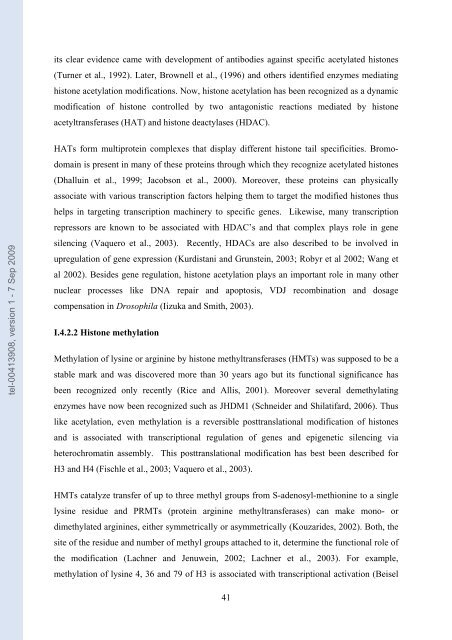Etudes sur le mécanisme de remodelage des nucléosomes par ...
Etudes sur le mécanisme de remodelage des nucléosomes par ...
Etudes sur le mécanisme de remodelage des nucléosomes par ...
Create successful ePaper yourself
Turn your PDF publications into a flip-book with our unique Google optimized e-Paper software.
tel-00413908, version 1 - 7 Sep 2009<br />
its c<strong>le</strong>ar evi<strong>de</strong>nce came with <strong>de</strong>velopment of antibodies against specific acetylated histones<br />
(Turner et al., 1992). Later, Brownell et al., (1996) and others i<strong>de</strong>ntified enzymes mediating<br />
histone acetylation modifications. Now, histone acetylation has been recognized as a dynamic<br />
modification of histone control<strong>le</strong>d by two antagonistic reactions mediated by histone<br />
acetyltransferases (HAT) and histone <strong>de</strong>actylases (HDAC).<br />
HATs form multiprotein comp<strong>le</strong>xes that display different histone tail specificities. Bromo-<br />
domain is present in many of these proteins through which they recognize acetylated histones<br />
(Dhalluin et al., 1999; Jacobson et al., 2000). Moreover, these proteins can physically<br />
associate with various transcription factors helping them to target the modified histones thus<br />
helps in targeting transcription machinery to specific genes. Likewise, many transcription<br />
repressors are known to be associated with HDAC’s and that comp<strong>le</strong>x plays ro<strong>le</strong> in gene<br />
si<strong>le</strong>ncing (Vaquero et al., 2003). Recently, HDACs are also <strong>de</strong>scribed to be involved in<br />
upregulation of gene expression (Kurdistani and Grunstein, 2003; Robyr et al 2002; Wang et<br />
al 2002). Besi<strong>de</strong>s gene regulation, histone acetylation plays an important ro<strong>le</strong> in many other<br />
nuc<strong>le</strong>ar processes like DNA repair and apoptosis, VDJ recombination and dosage<br />
compensation in Drosophila (Iizuka and Smith, 2003).<br />
I.4.2.2 Histone methylation<br />
Methylation of lysine or arginine by histone methyltransferases (HMTs) was supposed to be a<br />
stab<strong>le</strong> mark and was discovered more than 30 years ago but its functional significance has<br />
been recognized only recently (Rice and Allis, 2001). Moreover several <strong>de</strong>methylating<br />
enzymes have now been recognized such as JHDM1 (Schnei<strong>de</strong>r and Shilatifard, 2006). Thus<br />
like acetylation, even methylation is a reversib<strong>le</strong> posttranslational modification of histones<br />
and is associated with transcriptional regulation of genes and epigenetic si<strong>le</strong>ncing via<br />
heterochromatin assembly. This posttranslational modification has best been <strong>de</strong>scribed for<br />
H3 and H4 (Fisch<strong>le</strong> et al., 2003; Vaquero et al., 2003).<br />
HMTs catalyze transfer of up to three methyl groups from S-a<strong>de</strong>nosyl-methionine to a sing<strong>le</strong><br />
lysine residue and PRMTs (protein arginine methyltransferases) can make mono- or<br />
dimethylated arginines, either symmetrically or asymmetrically (Kouzari<strong>de</strong>s, 2002). Both, the<br />
site of the residue and number of methyl groups attached to it, <strong>de</strong>termine the functional ro<strong>le</strong> of<br />
the modification (Lachner and Jenuwein, 2002; Lachner et al., 2003). For examp<strong>le</strong>,<br />
methylation of lysine 4, 36 and 79 of H3 is associated with transcriptional activation (Beisel<br />
41

















